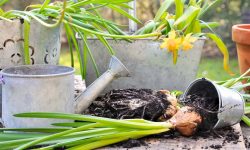Forget Me Nots are charming, delicate flowers that brighten any garden with vivid blue blooms. Their small, star-shaped flowers create a timeless appeal and attract pollinators such as bees and butterflies. Knowing the proper blooming time and care techniques is essential for gardeners to maximize their color and plant health.
Timing, sunlight, soil, and watering all influence Forget Me Not flowering. Proper attention ensures prolonged bloom periods and healthy growth. Understanding the plant’s growth cycle, including seasonal requirements, helps gardeners plan their garden effectively. This guide offers detailed advice on planting, maintenance, and blooming strategies to achieve a stunning display.
Understanding Forget Me Nots and Their Blooming Cycle

Forget Me Nots are biennial or short-lived perennial plants. They typically bloom in spring, often from mid-April to early June depending on climate. These flowers form seed heads after blooming, which can self-sow and produce new plants the following year. Their growth pattern requires attentive care during initial stages to ensure successful flowering.
Temperature and sunlight significantly impact bloom timing. Cool, moist conditions encourage robust flower production. In hot, dry climates, flowering may be delayed or reduced. Choosing the right planting location ensures optimal sunlight exposure and soil moisture. Regular observation allows gardeners to anticipate bloom periods and adjust care accordingly.
Pruning and deadheading are crucial to extending flowering. Removing spent flowers redirects plant energy to new bud formation. Fertilizing with phosphorus-rich nutrients supports healthy root and flower development. With consistent care, Forget Me Nots can provide a vibrant, continuous display, enhancing garden aesthetics throughout spring.
General Blooming Season of Forget Me Nots
Forget Me Nots thrive in springtime. Early blooms appear in cool climates by mid-April, while warmer regions may see flowers in late April. Flowering generally continues into early June, providing weeks of color. These small blue blossoms create a captivating garden focal point.
Timing is influenced by soil quality and moisture levels. Rich, well-drained soil promotes vigorous growth and healthy flowers. Regular watering during dry periods ensures sustained blooming. Mulching helps retain soil moisture and regulate temperature, supporting continuous flower production.
Gardeners should consider the plant’s biennial nature. First-year growth focuses on leaves and roots. Flowers appear in the second year, producing seed pods for future planting. Understanding this cycle ensures patience and proper planning, ultimately rewarding gardeners with vibrant Forget Me Not displays.
Blooming Cycle by Climate Zone
Blooming patterns of Forget Me Nots vary across climate zones. In cooler regions, flowers emerge later in spring, typically from mid-April to early May. Shorter growing seasons limit bloom duration, so gardeners should maximize sunlight and maintain soil moisture. Early-season frost may damage emerging buds, so protective measures help preserve flower health.
Moderate climates allow earlier flowering, usually starting in late March or early April. The extended spring supports longer blooms, often lasting into early June. Regular watering and nutrient-rich soil help sustain flowers during warmer periods. Mulching retains moisture and regulates temperature, promoting continuous flowering throughout the season.
In warmer zones, Forget Me Nots may bloom very early, sometimes in March, but high temperatures can shorten the flowering period. Providing afternoon shade and consistent irrigation prevents heat stress and extends bloom longevity. Planting in partial shade areas or offering supplemental care during peak summer heat ensures vibrant, long-lasting flowers. Understanding climate-based bloom cycles helps gardeners plan planting and maintenance for healthy, abundant displays in all regions.
Sunlight and Its Role in Blooming
Soil Conditions for Blooming Success
Forget Me Nots grow best in rich, well-drained soil with plenty of organic matter. Compacted or poorly drained soil limits root growth and reduces flowering. Amending soil with compost, peat, or leaf mold improves texture, drainage, and nutrient availability, creating ideal conditions for vigorous blooms.
The optimal soil pH is slightly acidic to neutral, between 6.0 and 7.0. This range supports nutrient absorption and overall plant health. Regular soil testing and adjustments with lime or sulfur ensure plants receive proper nutrients. Fertile soil encourages strong foliage and abundant flower production, prolonging the bloom period.
Consistent soil moisture is essential for healthy flowering. Evenly moist soil prevents stress that can reduce blooms. Mulching helps retain moisture, regulate temperature, and suppress competing weeds. Aerating soil and avoiding compaction allows roots to efficiently access water and nutrients. Proper soil management ensures Forget Me Nots reach their full blooming potential and display vibrant flowers throughout the season.
Watering Needs for Continuous Blooms
Forget Me Nots require consistent moisture to maintain healthy growth and prolonged flowering. Dry soil can stress plants, leading to reduced bloom quantity and size. Watering deeply and regularly, especially during dry spells, ensures roots receive adequate hydration and supports continuous flower production.
However, overwatering can cause root rot and other fungal diseases. Proper drainage is essential to prevent waterlogging. Gardeners should monitor soil moisture and adjust watering frequency based on rainfall, temperature, and soil type. A balanced approach promotes strong roots and vibrant blooms without risking plant health.
Mulching around Forget Me Not plants conserves soil moisture and regulates temperature. It also reduces evaporation and minimizes weed competition, allowing more nutrients and water to reach roots. Combining deep watering, proper drainage, and mulching ensures Forget Me Nots maintain consistent, healthy growth and deliver a stunning display of flowers throughout their blooming season.
Fertilizer and Nutrients for Strong Blooms
Choosing the Right Fertilizer
Forget Me Nots thrive when provided with balanced fertilizer that promotes healthy foliage and abundant flowers. Fertilizers rich in phosphorus support bud formation and enhance flower development. Early application during the growth stages ensures that plants receive essential nutrients needed for robust and vibrant blooms. Organic amendments, such as compost, well-rotted manure, or leaf mold, not only enrich the soil with nutrients but also improve its structure, aeration, and water-holding capacity. Slow-release fertilizers provide a consistent nutrient supply over time, preventing sudden spikes and ensuring steady growth. Regular feeding combined with good soil management encourages vigorous foliage, strong stems, and prolonged flowering periods. This careful attention ensures that Forget Me Nots remain productive and visually appealing throughout the season.
Additionally, a healthy soil ecosystem, including beneficial microbes, supports nutrient uptake and overall plant resilience. Combining chemical fertilizers with organic matter fosters a balanced environment, allowing the plants to thrive and produce a continuous display of blooms. The consistent availability of essential nutrients also strengthens plant immunity, reducing susceptibility to pests and diseases, and ensuring that flowers are abundant, colorful, and long-lasting.
Timing and Application
Proper timing of fertilizer application is critical for achieving maximum bloom performance. Fertilizing during the active growth and budding stages allows plants to allocate energy toward flower production instead of excessive leaf growth. Overuse of high-nitrogen fertilizers can lead to lush foliage but fewer flowers, so moderate, well-timed applications are essential. Gardeners should also consider the plant’s growth stage and adjust feeding schedules according to seasonal conditions and plant response. Watering plants before and after applying fertilizer helps prevent root burn and improves nutrient absorption. Ensuring that the soil is adequately moist allows roots to access nutrients efficiently and encourages consistent flowering throughout the season.
In addition, monitoring plant health and observing signs of nutrient deficiencies or excesses is important for optimizing bloom quality. Supplementing fertilizer with micronutrients like magnesium and iron can further enhance flower color and overall plant vitality. Combining the right fertilizer type, precise timing, and proper application methods ensures that Forget Me Nots produce strong, healthy growth and long-lasting, vibrant blooms. This approach maintains a visually striking garden display, supporting both plant health and aesthetic appeal throughout the flowering season.
Pruning Techniques to Enhance Blooming
Pruning Forget Me Nots is essential for encouraging vigorous growth and extended flowering. Removing dead or damaged stems prevents disease and allows the plant to allocate energy to healthy shoots and flowers. Early spring pruning shapes the plant, promotes air circulation, and enhances sunlight penetration, all of which support abundant blooms. Regular maintenance pruning throughout the growing season ensures the plant remains compact, prevents overcrowding, and improves overall health, leading to stronger and more colorful flowers.
Deadheading spent blooms is another crucial technique. Removing faded flowers encourages the plant to produce new buds instead of seed formation. This practice prolongs the flowering period and maintains visual appeal. Gardeners should carefully snip flowers just above the first set of healthy leaves, stimulating lateral growth and ensuring continuous bloom production. Deadheading also helps prevent disease by reducing decaying plant material and minimizing pest attraction.
Finally, selective thinning of overcrowded stems enhances bloom quality. By cutting back weaker or densely packed branches, gardeners direct nutrients to the most robust shoots, resulting in larger and more vibrant flowers. Proper pruning timing, combined with monitoring plant response, ensures Forget Me Nots maintain peak performance throughout the growing season. Regular attention to pruning techniques not only boosts flower quantity and quality but also promotes a healthy, visually appealing plant structure that thrives year after year.
Age of Plant and Blooming Maturity
The age of Forget Me Nots significantly influences blooming performance. Young plants usually focus on establishing roots and foliage, producing fewer flowers in their first year. As plants mature in the second or third year, they develop stronger root systems and more energy for flower production, resulting in larger and more consistent blooms. Understanding the growth stage helps gardeners set realistic expectations for flowering in early plant life.
Mature plants, typically two to three years old, demonstrate optimal bloom potential. At this stage, Forget Me Nots can produce numerous vibrant flowers due to well-established roots and robust foliage. Gardeners should provide consistent care, including watering, fertilizing, and pruning, to support flowering maturity. Observing plant health and growth patterns ensures that resources are allocated efficiently for flower production, maximizing bloom quality.
Additionally, age-related maintenance is important for sustaining bloom performance. Older plants may require division or rejuvenation pruning to maintain vigor and prevent decline. By periodically refreshing soil and managing plant size, gardeners can prolong the flowering lifespan of mature Forget Me Nots. Recognizing the relationship between plant age and flowering capacity allows for better planning and care, ensuring vibrant, long-lasting displays that enhance the garden season after season.
Pests and Diseases Affecting Blooms
Spring Care for Forget Me Nots
Spring marks the start of active growth for Forget Me Nots. Early pruning removes dead stems and encourages healthy new shoots. Fertilizing at this stage provides essential nutrients, supporting strong foliage and flower bud formation. Preparing the soil and maintaining consistent moisture helps young plants establish strong root systems, setting the stage for abundant blooms later.
Gardeners should also monitor for pests early in the season. Preventive treatments and attracting beneficial insects like ladybugs reduce damage. Ensuring sufficient sunlight and proper plant spacing promotes even growth. Thoughtful spring care creates a foundation for summer blooms, resulting in a vibrant, colorful garden display that maximizes the plants’ visual impact.
Summer Care for Maximum Blooms
Summer is the peak flowering season for Forget Me Nots. Regular watering supports heavy blooms and prevents stress from heat. Deadheading spent flowers encourages continuous bloom production and maintains an attractive appearance. Monitoring for pests and diseases ensures plants remain healthy and productive. Fertilizing during this stage provides essential nutrients to sustain flowering and overall plant vigor.
Light trimming manages plant size and encourages lateral growth, improving airflow and sunlight penetration. Mulching conserves soil moisture and regulates soil temperature, which is crucial during hot summer months. Maintaining consistent care routines allows Forget Me Nots to thrive, producing vibrant, long-lasting flowers. Careful summer management ensures a prolonged, colorful display that enhances the garden’s aesthetics and creates a lively, flourishing outdoor environment.
Fall Care to Prepare for Dormancy
Fall signals a slowdown in Forget Me Nots growth as temperatures drop. Cutting back overgrown stems helps control plant size and improves air circulation. Cleaning the garden area removes fallen leaves and debris, preventing pests and diseases from overwintering and affecting plant health. Pruning lightly also encourages a neat structure and reduces the risk of fungal infections during cold, damp months.
Mulching is essential to protect roots from frost and conserve soil moisture. Using organic mulch like straw or shredded leaves insulates the root zone and stabilizes soil temperature. Reducing fertilizer and watering as plants prepare for dormancy prevents overstimulation and nutrient overload. Proper fall care ensures Forget Me Nots remain healthy, ready for vigorous growth in the next season, and sustain their bloom potential year after year. Attention to detail during this period secures a strong foundation for spring flowering.
Winter Protection and Maintenance
During winter, Forget Me Nots enter dormancy and require protection from frost and extreme temperatures. Mulching and using protective covers reduce root damage and maintain stable soil conditions. Avoid heavy pruning, as it can stress dormant plants and reduce spring vigor.
Monitoring for signs of winter pests, such as slugs or rodents, helps prevent damage. Ensuring minimal disturbance and checking soil moisture occasionally maintains plant health. Winter maintenance, including insulation and careful observation, ensures Forget Me Nots survive the cold season and resume growth effectively. These practices prepare the plants to produce vibrant, stunning flowers when spring arrives, supporting a healthy, continuous garden display.
How to Extend the Blooming Season
Extending the bloom season for Forget Me Nots requires consistent care and attention. Regular deadheading removes spent flowers and encourages new buds. This prevents the plant from wasting energy on seed production and allows it to focus on creating more blooms. Timing deadheading throughout the flowering period helps maintain continuous color and ensures a longer-lasting display in the garden.
Consistent watering is crucial for prolonging blooms. Forget Me Nots need evenly moist soil, especially during hot or dry periods. Proper watering prevents stress that can cause premature wilting. Supplementary feeding with a balanced, water-soluble fertilizer supports continuous flowering by providing essential nutrients for bud development. Monitoring soil moisture and adjusting care as needed ensures the plants remain healthy and vibrant.
Environmental control also contributes to bloom longevity. Providing partial shade during extreme heat prevents flower scorching, while proper plant spacing improves air circulation and reduces disease risk. In cooler climates, protective covers can shield plants from unexpected frosts. Combining deadheading, consistent watering and fertilization, and environmental management allows gardeners to enjoy a prolonged flowering season, keeping Forget Me Nots vibrant and colorful for an extended period.
Common Blooming Problems and Solutions
Insufficient Sunlight
Forget Me Nots require adequate sunlight to produce vibrant blooms. Plants in full shade often have fewer flowers, weaker stems, and slower growth. Providing at least 4–6 hours of direct or filtered sunlight daily promotes strong, healthy growth and abundant flowering. Sunlight also helps keep foliage dry, reducing the risk of fungal diseases like powdery mildew. Without sufficient light, plants can become leggy and fail to reach their full bloom potential.
If plants are in low-light areas, relocate them to sunnier spots or trim surrounding trees and shrubs that block sunlight. Using reflective surfaces or light-colored mulch can further enhance light exposure. Proper sunlight management ensures robust stems, healthier leaves, and consistent blooms. It also improves overall plant vigor, making flowers more colorful and long-lasting. Regular assessment of light availability and adjusting plant placement helps maintain continuous blooms and a visually appealing garden display throughout the growing season.
Overcrowding and Poor Airflow
Overcrowded Forget Me Nots experience reduced flowering and higher disease risk. Limited airflow creates a humid environment that promotes fungal infections such as powdery mildew and leaf spot, weakening plants and limiting bloom production. Dense planting also leads to competition for nutrients, water, and sunlight, further reducing flower output.
Thinning plants periodically improves air circulation and allows sunlight to penetrate. Proper spacing during planting ensures each plant has enough room to grow without competition. Maintaining adequate spacing reduces plant stress, lowers disease risk, and supports vibrant, consistent blooms. Encouraging airflow also regulates temperature and moisture, critical for healthy flower development throughout the season.
Nutrient Deficiency
Nutrient deficiencies hinder Forget Me Nots’ flowering. Poor soil or improper fertilization leads to weak growth, fewer blooms, and pale or discolored leaves. Essential nutrients, particularly nitrogen, phosphorus, and potassium, are vital for foliage growth, root development, and flower production.
Amending soil with compost or balanced fertilizer provides necessary nutrients for vigorous growth. Monitoring plant health and adjusting fertilization schedules ensures adequate nourishment throughout the growing season. Well-fed Forget Me Nots produce more vibrant, long-lasting flowers and maintain lush foliage. Adequate nutrition also increases resilience against stress and disease, supporting continuous colorful blooms that enhance the garden’s beauty.
Benefits of Forget Me Not Blooms
Forget Me Not blooms offer numerous aesthetic benefits. Their delicate, bright flowers add vibrant color to gardens, flower beds, and containers. These small blooms create a soft, charming visual appeal that complements larger plants and greenery. Mass plantings produce a striking carpet of color, ideal for borders, pathways, and naturalized areas, enhancing garden design and visual interest.
In addition to aesthetics, Forget Me Not flowers attract pollinators. Bees, butterflies, and other beneficial insects are drawn to the nectar-rich blooms. Pollinator visits improve the overall health and productivity of the garden, supporting nearby fruits, vegetables, and other flowering plants. This natural interaction promotes biodiversity, helping maintain a balanced ecosystem in home gardens and larger landscapes.
Forget Me Not blooms also hold symbolic value. They are associated with remembrance, love, and loyalty, making them popular in memorial gardens, sentimental plantings, and gifts. Their long-lasting flowers, when properly cared for, provide continuous color throughout the growing season. These blooms not only enhance beauty but also contribute to ecological benefits and emotional connections, making Forget Me Nots a valuable addition to any garden, creating both visual and symbolic impact.
Landscaping Ideas with Forget Me Nots
Forget Me Nots are versatile plants for landscaping. Their compact size and vibrant blooms make them ideal for borders, edging, and underplanting larger shrubs or perennials. Planting them in groups creates a continuous splash of color that draws the eye and enhances garden aesthetics. Using these blooms along pathways or garden beds adds charm and guides visitors through the landscape.
These flowers thrive in various settings, from formal gardens to naturalized areas. Combining Forget Me Nots with complementary plants like tulips, daffodils, or hostas creates visual contrast and layered interest. Their soft blue flowers pair beautifully with white, pink, and purple blooms, adding depth and harmony to any design. By integrating them into mixed beds or rock gardens, gardeners can create textured, dynamic landscapes that remain vibrant throughout the growing season.
Container gardening is another effective use for Forget Me Nots. Placing them in pots, window boxes, or hanging baskets allows for flexible placement and seasonal rotation. Containers also make it easier to control soil conditions and monitor watering, ensuring optimal growth and bloom performance. Thoughtful placement of these plants enhances curb appeal and brings color to patios, balconies, and other small spaces, making Forget Me Nots a practical and attractive choice for diverse landscaping projects.
FAQ About When Forget Me Nots bloom
When do Forget Me Nots typically bloom?
Forget Me Nots usually bloom in spring, from April to June. Bloom timing depends on climate, sunlight, and soil. Cooler areas may delay flowering, while warmer regions may see earlier blooms. Regular care and optimal conditions ensure a full, vibrant flowering period, maximizing visual appeal.
How often should I water Forget Me Nots?
These plants prefer consistently moist soil without waterlogging. Water regularly, especially during dry spells in spring and early summer. Proper watering promotes healthy growth, prevents wilting, and encourages continuous blooms. Mulching helps retain soil moisture and reduces watering frequency, keeping the plants strong and vibrant.
What type of soil is best for Forget Me Nots?
Forget Me Nots thrive in well-draining, fertile soil enriched with organic matter. Slightly acidic to neutral pH is ideal. Poor or compacted soil can hinder flowering. Amending with compost or organic material improves texture and nutrients, supporting strong roots and maximizing bloom quantity and quality.
How do I prevent diseases in Forget Me Nots?
Ensure good airflow with proper spacing and avoid overhead watering. Remove garden debris regularly. Monitor for fungal infections like powdery mildew and leaf spot. Prune affected leaves promptly. Proper sunlight and soil drainage help maintain plant health and reduce disease-related bloom loss.
Can Forget Me Nots self-seed, and should I control it?
Yes, Forget Me Nots can self-seed extensively, creating naturalized areas. Deadhead spent flowers or remove seed heads to prevent overcrowding. Managing self-seeding maintains plant health, ensures proper spacing, and supports consistent bloom quality throughout the season.
Conclusion
Forget Me Nots are charming, versatile flowers that bring lasting beauty to any garden. With proper care, including sunlight, watering, and soil management, they flourish and create vibrant displays. Regular maintenance, disease prevention, and thoughtful placement extend blooming and overall health. Their aesthetic appeal, pollinator support, and symbolic meaning make them valuable additions to landscapes. By understanding their needs and applying expert tips, gardeners can enjoy continuous, stunning Forget Me Not blooms every year, enhancing any outdoor space with color, charm, and visual interest throughout the growing season.






